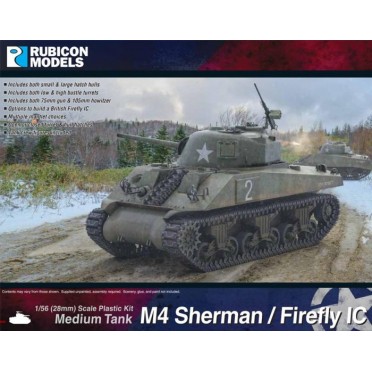M4 Sherman/Firefly IC
RUB-RU-280060
- From 14 years old
The M4 Sherman, officially Medium Tank, M4, was the most widely used medium tank by the United States and Western Allies in WW2. The M4 Sherman proved to be reliable, relatively cheap to produce, and available in great numbers. Thousands were distributed through the Lend-Lease program to the British Commonwealth and the Soviet Union. The tank was named by the British for the American Civil War General William Tecumseh Sherman.
The M4 Sherman evolved from the M3 Medium Tank, which had its main armament in a side sponson mount. The M4 retained much of the previous mechanical design, but housed the main 75mm gun in a fully traversing turret. One feature, a one-axis gyrostabilizer, was not precise enough to allow firing when moving but did help keep the reticle on target, so that when the tank did stop to fire, the gun would be aimed in roughly the right direction. The designers stressed mechanical reliability, ease of production and maintenance, durability, standardization of parts and ammunition in a limited number of variants, and moderate size and weight. These factors, combined with Sherman’s then-superior armour and armament, outclassed German light and medium tanks fielded in 1939 to 42. The M4 went on to be produced in large numbers. It spearheaded many offensives by the Western Allies after 1942.
When the M4 tank (Sherman I by the British naming system) went into combat in North Africa with the British Army at El Alamein in late 1942, it increased the advantage of Allied armour over Axis armour and was superior to the lighter German and Italian tank designs. For this reason, the US Army believed that the M4 would be adequate to win the war, and no pressure was exerted for further tank development. Logistical and transport restrictions, such as limitations imposed by roads, ports, and bridges, also complicated the introduction of a more capable but heavier tank. Tank destroyer battalions using vehicles built on the M4 hull and chassis, but with open-topped turrets and more potent high-velocity guns, also entered widespread use in the Allied armies. Even by 1944, most M4 Shermans kept their dual purpose 75mm gun. By 1944, the M4 was inferior in firepower and armour to increasing numbers of German heavy tanks, but was able to fight on with numerical superiority and mutual support from growing numbers of fighter-bombers and artillery pieces. Some Shermans were produced with a more capable gun, the 76mm gun M1, or refitted with an Ordnance QF17-pounder by the British (the Sherman Firefly).
The relative ease of production allowed large numbers of the M4 to be manufactured and significant investment in tank recovery and repair units allowed disabled vehicles to be repaired and returned to service quickly. These factors combined to give the Allies numerical superiority in most battles, and many infantry divisions were provided with M4s and tank destroyers.
After World War II, the Sherman, particularly the many improved and upgraded versions, continued to see combat service in many conflicts around the world, including the UN forces in the Korean War, with Israel in the Arab-Israeli Wars, briefly with South Vietnam in the Vietnam War, and on both sides of the Indo-Pakistani War of 1965.
Product Highlights:
- Includes both small & large hatch hulls
- Includes both low & high bustle turrets
- Includes both 75mm gun & 105mm howitzer
- Options to build a British Firefly IC
- Multiple mantlet choices
- Open or closed turret & hull hatches
- Tank crew figures included
Copyright © 2025 www.philibertnet.com Legals - Privacy Policy - Cookie Preferences - Sitemap





